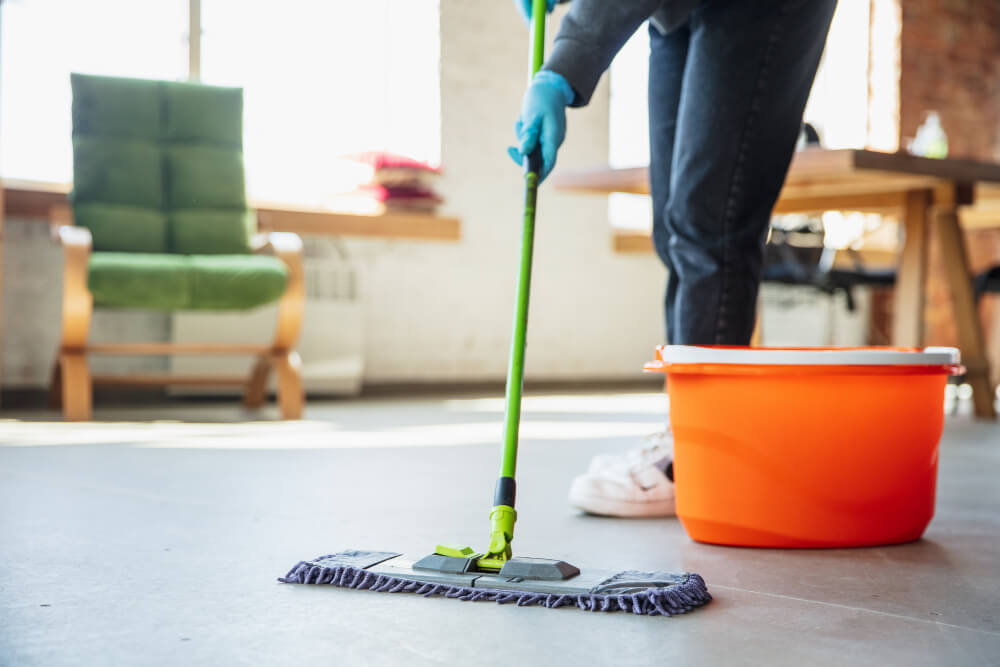If you have epoxy floor coating in your home or business, it’s important to clean it on a regular basis. Resin flooring is very durable and can last for years with proper care. In this step-by-step guide, we will show you how to clean epoxy floors quickly and easily. Keep in mind that the exact cleaning procedure may vary depending on the type of epoxy coating that you have. Always consult the manufacturer’s instructions before starting any clean-up project.
Step 1: Performing General Maintenance
The first step in cleaning epoxy floors is to perform general maintenance. This includes sweeping, dusting, and mopping the floor regularly. Doing this will help to remove any dirt or debris that could potentially damage the epoxy coating.
Step 1.1: Dust mop once a week
To dust mop your epoxy floor once a week, start by sweeping the floor with a broom to remove any loose dirt and debris. Then, use a dry mop or dust mop to pick up any remaining dirt and dust. Be sure to move the mop in a back-and-forth motion to avoid missing any spots.
Step 1.2: Vacuum any joints once a month
To vacuum the joints on your epoxy floor, start by using a dust brush to remove any loose dirt and debris. Then, use a vacuum cleaner with a soft brush attachment to reach any tight spaces. Be sure to move the vacuum cleaner in a back-and-forth motion to avoid missing any spots.
Step 1.3: Clean spills immediately with a soft cloth
To clean spills on your epoxy floor, start by blotting the area with a soft cloth to absorb as much of the spill as possible. Then, use a mild detergent and warm water to remove any remaining residue. Be sure to rinse the area well and dry it completely before walking on it.
Step 2: Doing a Deep Cleaning
The second step in cleaning epoxy floors is to do a deep cleaning. This should be done at least once every three months, or more often if needed. When doing a deep cleaning, it’s important to use the right products and tools to avoid damaging the epoxy coating.
Step 2.1: Perform a deep cleaning every three months
It’s important to do a deep cleaning every three months because it helps remove built-up dirt, grease, and grime on the floor. This can help improve the appearance of the floor and also extend its life. In order to accomplish this, you may need to move some vehicles, tools, or other items out of your way.
Deep cleaning can be done using a commercial cleaner or a home remedy such as vinegar and water. Be sure to follow the manufacturer’s instructions for the best results. And always test any cleaner on a small area of the floor first to make sure it doesn’t damage the surface.
Step 2.2: Choose a cleaning solution
There are a variety of cleaning solutions that can be used to clean epoxy floors. However, it’s important to choose the right one for your specific floor type. For example, if you have a glossy floor, you’ll want to use a cleaner that is designed for shiny surfaces. If you have a textured floor, you’ll want to use a cleaner that is designed for textured surfaces.
Step 2.3: Mop the floor with a hard foam mop
Once you’ve chosen the right cleaning solution, it’s time to start mopping the floor. Be sure to use a hard foam mop so that you don’t damage the epoxy coating. Start in one corner of the room and work your way across in small sections. Be sure to rinse the mop often to avoid leaving streaks on the floor.
Step 2.4: Rinse the floor
When you’re finished mopping, be sure to rinse the floor with clean water and dry it completely. This will help remove any leftover cleaner and prevent streaks from forming on the floor. Be sure to use a squeegee or cloth to remove any excess water from corners or tight spaces. Once the floor is dry, you can put all of your vehicles, tools, and other items back in place.
Step 3: Removing Stains
There are a few different methods that can be used to remove stains from epoxy floors. The best method will depend on the type of stain you’re dealing with. For example, if you have an oil-based stain, you’ll want to use a solvent-based cleaner. If you have a water-based stain, you’ll want to use a detergent-based cleaner. And if you have a rust stain, you’ll want to use an acidic cleaner. Be sure to test any cleaner on a small area of the floor first to make sure it doesn’t damage the surface.
Step 3.1: Scrub stubborn spots with a stiff nylon brush
If you have any stubborn spots on your epoxy floor, you can try scrubbing them with a stiff nylon brush. The bristles of a stiff nylon brush can help to loosen and remove stubborn dirt and debris from an epoxy floor. When used in combination with a cleaning solution, this method can be an effective way to clean an epoxy floor.
Step 3.2: Clean rust stains or salt film with a lactic acid-based cleanser
If you have any rust stains or salt film on your epoxy floor, you can try cleaning them with a lactic acid-based cleanser. This type of cleaner is designed to remove tough stains and build-up from an epoxy floor. Be sure to follow the manufacturer’s instructions for the best results.
Step 3.3: Remove tire marks with a concrete degreaser
If you have tire marks on your concrete floor, using a concrete degreaser can help remove them. Concrete degreasers are specifically designed to cut through the grease and oils that are often left behind by tires. They work quickly and easily, leaving your floor clean and ready for epoxy coating.
Summary
Cleaning epoxy floors or resin flooring is a simple process that can be done using a variety of different methods. Be sure to choose the right method for your specific floor type and stain. With a little elbow grease, you can have your epoxy floor looking like new in no time. Thanks for reading! We hope this guide was helpful. If you have any questions or comments, please feel free to reach out to us. We would be more than happy to help!
This article is posted on GetLocal MY.



